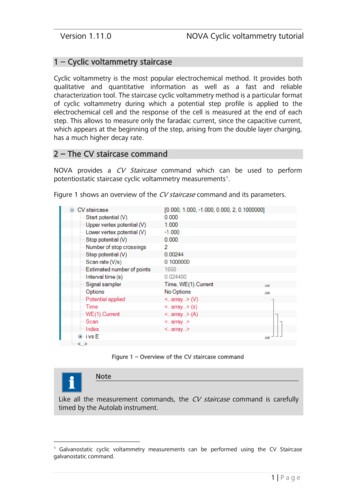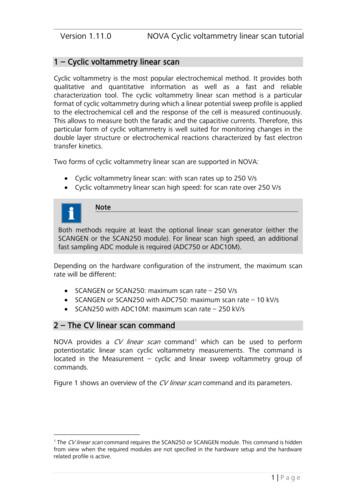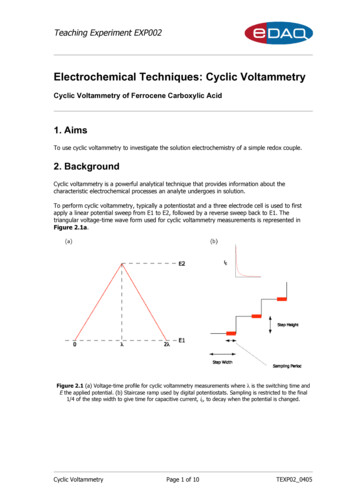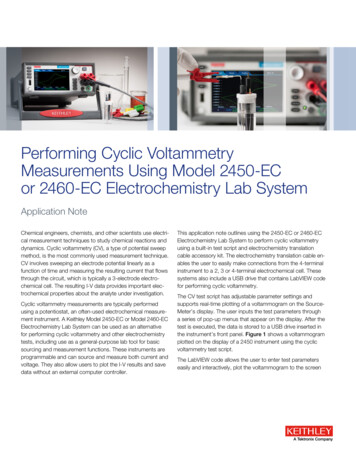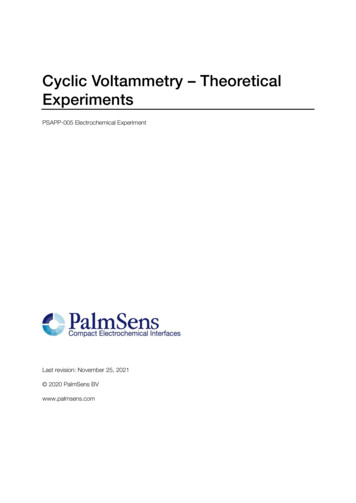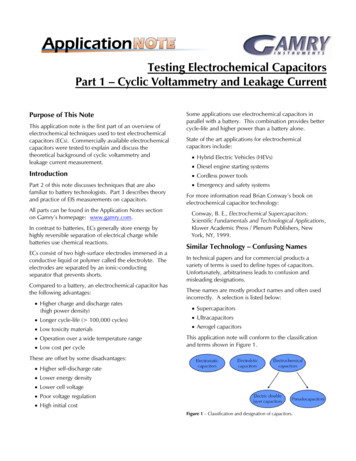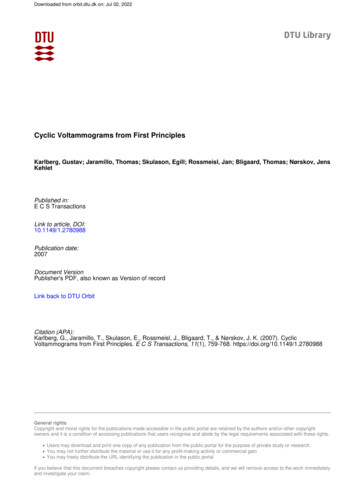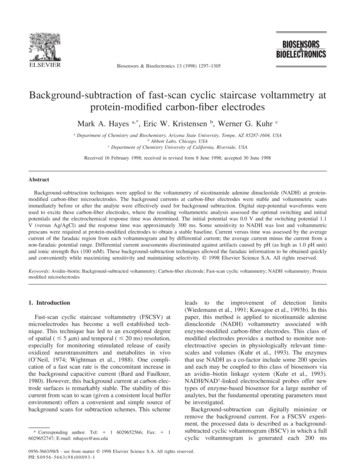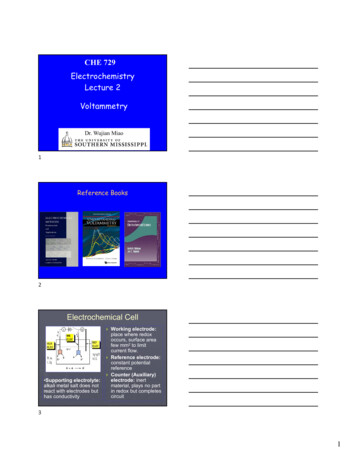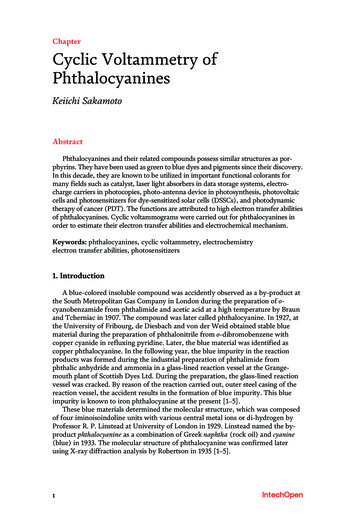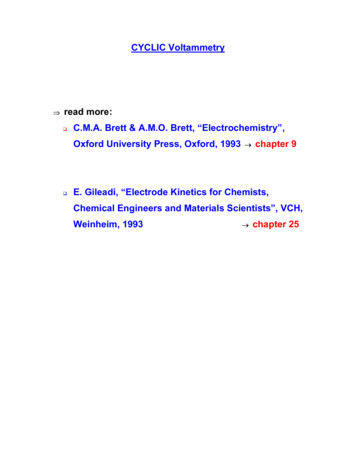
Transcription
CYCLIC Voltammetry read more: C.M.A. Brett & A.M.O. Brett, “Electrochemistry”,Oxford University Press, Oxford, 1993 chapter 9E. Gileadi, “Electrode Kinetics for Chemists,Chemical Engineers and Materials Scientists”, VCH,Weinheim, 1993 chapter 25
Different ways to do voltammetry: Potential step Linear sweep Cyclic Voltammetry (CV)CV: widely used technique for studying electrodeprocesses (particularly by non-electrochemists)Principle of CV: Apply continuous cyclic potential E toworking electrode Effects Faradic reactions: oxidation/reduction ofelectroactive species in solution Adsorption/desorption due to E Capacitive current: double layer chargingdc 0deviations from steady state, i.e.dt
kineticsmass transportj vs. Ej vs. tCV:j E t planedEdt Potential changed at a constant sweep rate, v Cycled forward and backward between fixed values Current plotted as a function of potentialEEmaxEiEftEmin
In principle: useful Unknown electrochemical system start analysis with CV survey over processes, kinetics identify involved species and mechanisms qualitative understandingSemi-quantitative analysis diagnostic capabilities but difficult to understand and analyze a lot of informationdifficult to discern!!!
How do typical cyclic voltammograms look like?
Measured Currentfaradaic current electrode reaction capacitive currentdouble layer chargingtotal current density:j jF jC jF CddEdtj jF vCdrate constantsdouble layer correctionDouble layer correction important if v is large!What do we need? Nernst-equation Butler-Volmer equation Diffusion equation Double layer charging Adsorption anything new? equilibriumkineticsmass transport
What is controlled in CV?Variation of applied potential with timeEEmaxEiEftEminImportant parameters: Initial potential , Ei Initial sweep direction -1Sweep rate, v [mV s ] Maximum potential, Emaxsolvent Minimum potential, Eminstability Final potential, E f mV s-1 to 103-104 V s-1
Sweep rate: 3 ranges of operation(1)very slow sweeps ( nothing new!)v 0.1 2 mV s-1quasi-steady state conditionssweep rate and reversal: no effect on j/E relationship(2) corrosion passivation fuel cell reactionsOxidation or reduction of species in the bulkv 0.01 100 V s-1measurementtime (10-50 s)(mass transport)(3) double layer charging uncompensatedsolution resistanceOxidation/reduction of species on surfacev 0.01 100 V s-1background currents,impurities double layer charging uncompensatedsolution resistance
Optimum range of concentration and sweep rate03-2mM001M10 m-421M1mmM0.1mM0.01-6jC (capacitice current )-8-4-2024log vat 1 mV s-1: jC 20 nA cm-2(1) jF (at peak) 10 jC(2) v 10 mV s-1 (avoid convection)-2(3) jF (at peak) 20 mA cm(minimize effect of uncompensated solution resistance)(4) c b 100 mM(permit addition of supporting electrolyte)but: cb 0.1 mM (double layer charging)What about porous (rough) electrodes? Would they helpimproving the range of sweep rates?
Let’s look at some typical CVsConsider CV for simple electron transfer processe.g. Fe2 Fe3 e- (M) (anodic) – which quadrant?Fe3 e- (M) Fe3 (cathodic) – which quadrant?Why is a peak observed in this plot?Why is j 0 at E E eq (or why is CV asymmetric)?
Let’s start in Lower left corner (cathodic region):E E eq cathodic current ( 0)cox consumed (depleted near electrode)cred produced (enhanced near electrode) j 0 at E E eq (remember Nernst equation!) E increases towards upper right corner (anodic)cred depletedcox produced peak is reached at j jp , E EpWhat causes occurrence of peak?
Of course: Interplay of diffusion and mass transport!Consider: simple phenomenologykineticsactivation controljacmass transportdiffusion controljdiffResulting current: initially:111 j jac jdiffjac jdiff j jac j increases with E (and t ) t proceeds, E growsuntil jac jdiffjacand jdiffMAXIMUM t further progress: jac jdiff j jdiff j decreases with E (and t )You see: Same phenomena (and equations) as before!
Now: More detail!Distinguish:reversible regionTafel region(“irreversible”)Which fundamental parameter is this distinction relatedto?
Semi-quantitative treatment of CV(1) Simple, reversible electron transfer planar electrodeMSe-Diffusion equations (both species):O n e-O , cox cox 2 cox DO t x 2R, cred cred 2 cred DR t x 2RInitial and boundary conditions:sbt 0, x 0 (interface): cox coxt 0, x (bulk):sb(1), cred cred 0 (2)bcox cox(3), cred 0(4)Mass balance:flux of “ox” (reaching surface) flux of “red” (leaving surface)DO cox c DR red 0 (5) x x(careful: provided that both species are soluble!)One condition is missing! – “The reversible case”
What does “reversibility” mean in this context?sConcentrations at the surface, cox/red , and potential E arerelated via (6) Nernst-equationsRT cox ( t )E (t) E ln snF cred(t )0 linear Tafel region (high overpotentials)() 1 α C F E E0sexp nFk 0 cox RT c nFDO ox x x 0Potential is externally controlled function of time:cathodic scan:anodic scan:E Ei vt ,E Ei vtrev v ( t trev ) ,for0 t trevfortrev tOverall:Well-defined problem! Diffusion equations can be solvedwith given conditions in Laplace-domain – however, yDon’t go through this!Let’s consider instead some important parameters!done
Quantitative parameters for reversible CVsPeak potential:Ep (rev ) E1/ 2 1.1 : anodic sweepHere: E1/ 2- : cathodic sweep1j jdiffis the half-wave potential at which2E1/ 2usually:RTnFE1/ 2 E 0RT DO ln E0 nF DR 1/ 2since ( DO DR )Note: Ep ( rev ) is independent ofv(criterion for reversibility!!!) Ep ( rev ) is independent of concentration!
Peak current density: nFDO jp (rev ) 0.446nF RT 1/ 2b 1/ 2coxvb 10 4 mol cm-3e.g.: n 1, DO 2.0 10 5 cm2 s-1, coxjp (rev ) 0.12 A cm-2 v 1/ 2 [in V s-1 ]at room T:b v 1/ 2jp (rev ) 2.72 105 n 3 / 2 DO1/ 2 cox A cm2 cm2 mol 3 s cm V s
Diagnostic information in reversible CV: jp v 1/ 2 Ep independent of v( Ep Ep/2 56.6mV , where Ep/2 E I Ip 2n Ep,a Ep,c 57mVn Ip,a Ip,c 1)
(2) Irreversible ET at planar electrode, linear Tafel regionSMlinear sweep and CV lead toe-O , cox the same voltammetric profile,no inverse peak appears onR, credO n e-inversing the scan directionRReduction as an example cnFDO ox xx 0( 1 α C nFk c exp 1 α Cs nFk 0 coxexp 0 sox(where E Ei vt and β ) F ( E E ) 0 F Ei E 0 x exp ( β t ) RT RT) ((1 α C ) F vRT)
Peak potential: 1 α FD RT11C)O 0.780 ln (Ep (irrev ) E ln v 2 RT k 0 2 2(1 α C ) F 0( )i.e. depends on ln vPeak current density:bjp,c (irrev ) 2.99 105 n (1 α C ) coxDO1/ 2 v 1/ 2 A mol cm2 cm3 52 -1be.g.: α C 0, n 1, DO 2.0 10 cm s , cox cm2 V s s 4 10 mol cm-3jp (irrev ) 0.134 A cm-2 v 1/ 2 [in V s-1 ]Alternative expression for jp,c (irrev ) :() ( 1 α C F E p (irrev ) E 0j p ,c ( irrev ) 0.227 nFk c exp RT 0 soxeffect of mass transport!Ratio of peak current densities (simple ET)jp (irrev )jp (rev ) 1 αC 1.107 n 1/ 2jp (irrev ) 0.78 (usually 1)α 0.5,n 1e.g. Cjp (rev ))
Linear sweep voltammogram for irreversible systemjjp,cn(E-Ep) / V well-separated anodic and cathodic peak(independent) current decay upon invertinging sweep direction peaks at larger (over)potentials compared toreversible system Ep (irrev ) depends on sweep rate largerv broader and lower peaks, i.e. moreirreversible
Peak potential as a function of sweep rateReversibility is controlled by sweep ratev!
Quasi-reversible systemsGeneral rule: “irreversibility” increases withincreasing sweep ratevExtent of “irreversibility”: large sweep rates widely separated anodic and cathodic peaks decrease in peak current relative to the reversiblecase
CV: technique with potential control!!! – Problematic! Problem: potential dropjRu due to uncompensatedsolution resistance Actual interfacial potential is smaller than controlledpotential (between -WE and CE), Eint Ef jRu Effect: reduced current peak (flattened CV) at apparentlyhigher potentialwith dynamicjRu correctionjRuQuinhydrone(5 mM) in1 mM H2SO4,withoutv 75 mV s-1correctionDistorted shape of CV in particular in vicinity of peak:effectively reduced sweep rate at the interface near peak!
Determine peak current density in CV extrapolate baseline (no theoretical basis for this –imaginative extrapolation) weakness of CV when used as a quantitative tool
Use of CV: qualitative studies of reactions in certainpotential rangeExample 1: CV of dropping mercury electrode (DME) insolution of p-nitrosphenol in acetate buffer Start at 0.3 V vs. SCE in cathodic direction:first reduction peak at -0.1 Vp-nitrosphenolp-phenolhydoxylamine
anodic return sweep: reverse reaction peak at -0.05 V,position as expected, but suppressed another unexpected anodic peak at 0.22V,corresponds to cathodic peak not seen in first scan!What is going on?Chemical reaction following charge transferProducing new redox couple!Decomposition of inone
New redox couple:p-aminophenolReaction sequence: ECE mechanism(electrochemical – chemical – electrochemical)
Example 2: reduction of Ti4 in 1:2 NaCl/AlCl3, Ti2 fromanodic dissolution of Ti, Al-wire as reference electrode(separate compartment)Sweep rate (or scan rate): v 100 mV s-1Two reduction steps, separated by 0.5 V.Reversibe or irreversible steps? Which step has the higherrate constant?
60 mV
Different ways to do voltammetry: Potential step Linear sweep Cyclic Voltammetry (CV) CV: widely used technique for studying electrode processes (particularly by non-electrochemists) Principle of CV: Apply continuous cyclic potential E to working electrode Effects Faradic reactions: oxidation/reduction of
